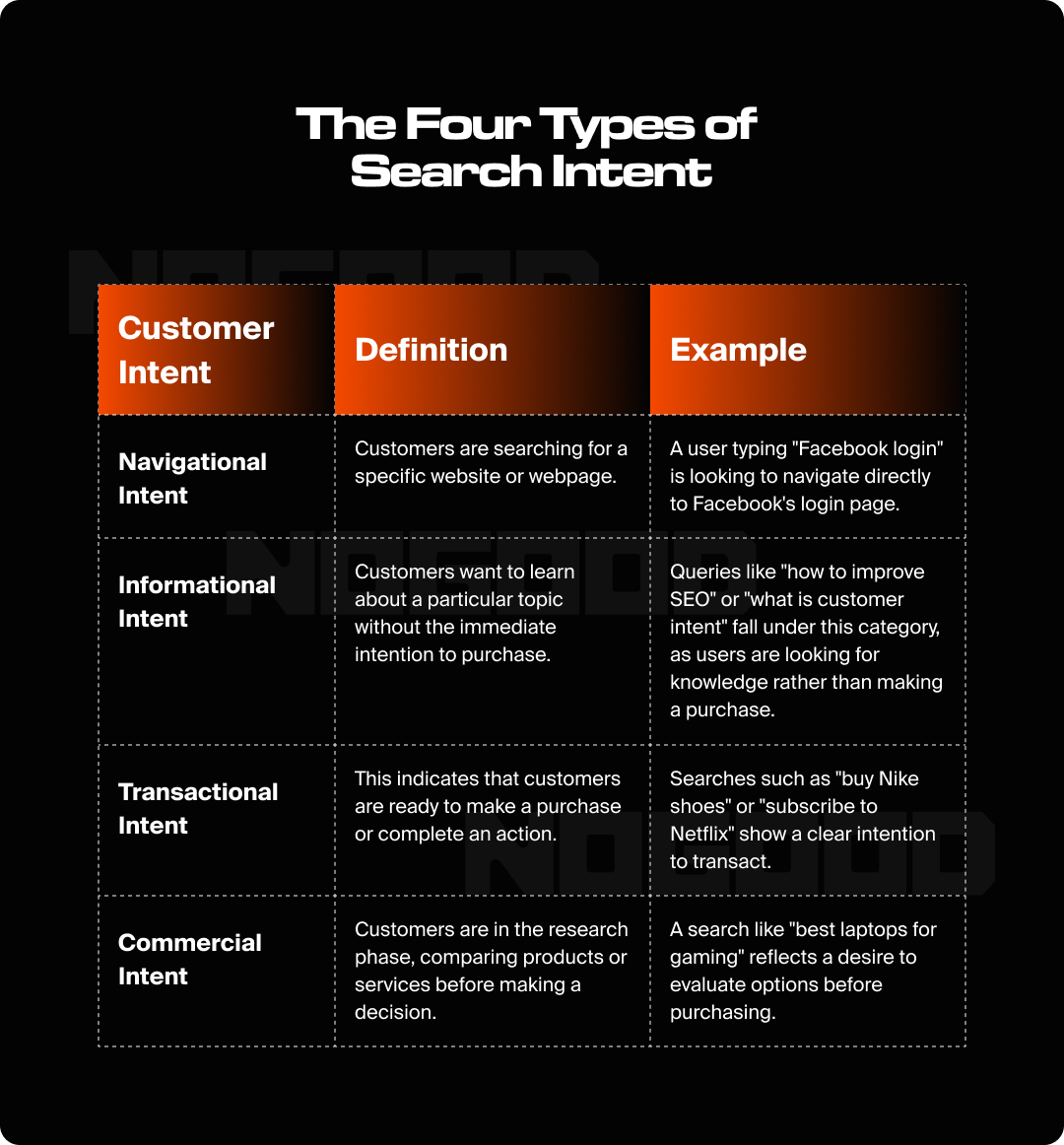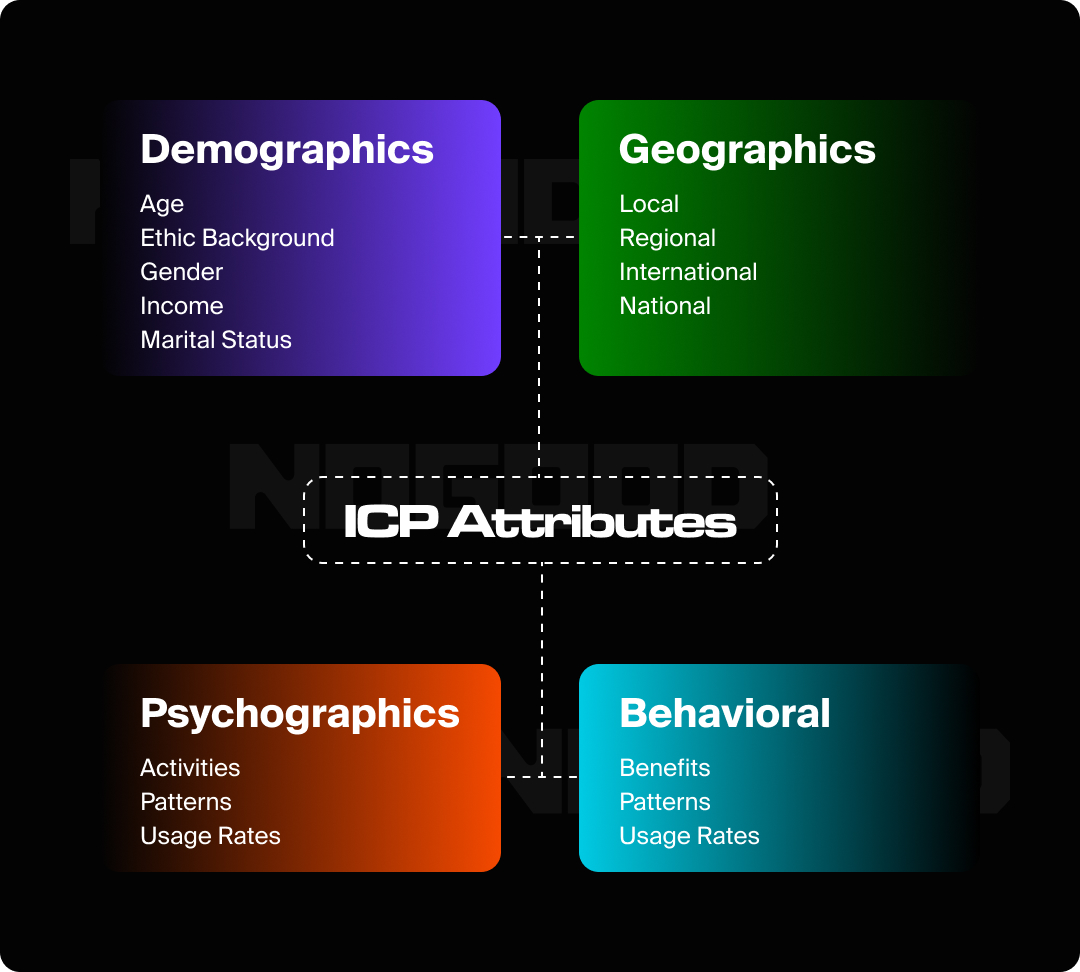One of the most effective strategies for gaining a competitive edge is mastering niche keyword research. Unlike broad keywords that attract a wide audience, niche keywords allow you to connect with specific segments of your target market, driving highly relevant traffic to your website.
Niche keyword research comes down to finding long-tail keywords that resonate with your target audience, driving engagements and conversions. These long-tail keywords are present in around 70% of searches, making them an easy target for marketers looking to drive engaged traffic.
Understanding Search Intent
Search intent is the underlying motive behind a user’s online query — what they’re really looking to find. Recognizing this intent is a game-changer in keyword research because it guides you to the keywords that resonate with your audience’s needs. When you tap into the actual intent, you’re not just picking keywords; you’re matching your content to what your audience needs, whether that’s information, a product, or a solution to a problem.
There are four types of search intent: informational, navigational, commercial, and transactional. Informational intent means the user is looking for answers or insights, like “how to save energy at home.” Navigational intent is when someone is trying to reach a specific site, such as typing “Tesla official site.”
Transactional intent indicates readiness to buy or engage in a commercial activity, like “buy eco-friendly water bottle.” Commercial intent is when someone is in the research phase of comparing different products and companies, like “best electric vehicles.”

When content matches search intent, it usually results in better engagement and higher organic traffic. For instance, if a blog post answers a common question thoroughly, users are more likely to stay on the page, explore further, or even share the content. Shifting your focus to addressing specific user queries in blog posts leads to a noticeable uptick in both page views and user interaction.
Incorporating search intent into your keyword research isn’t just about picking the right words; it’s about understanding and meeting your audience’s needs at every step of their online journey.
4 Steps to Conduct Niche Keyword Research
Step 1. Define Your Target Audience

Start by asking yourself: Who are my ideal customers? What are their interests, needs, & pain points? Consider creating detailed buyer personas that include demographics, psychographics, and buying behaviors. Dive deep into their world — where do they hang out online? What kind of content do they consume? What questions are they asking that your product or service can answer?
Let’s look at an example. Consider Carla, a savvy marketer for a skincare brand. She noticed that her products weren’t getting the traction she expected. Instead of just throwing more content out there, she took a step back and decided to get to know her audience better.
Through surveys and social media interactions, she discovered that her target market was not just interested in skincare products but was also passionate about DIY beauty tips. With this insight, she tailored her content strategy to include DIY skincare recipes alongside promoting her products. The result? A significant increase in engagement and sales.
Platforms like Reddit, Quora, and Facebook groups can provide insights into the types of questions and topics your audience is interested in. Search for forums related to your niche by using search strings like “keyword + forum” to discover discussions that could lead to niche keywords.
Understanding your audience isn’t just about gathering data; it’s about seeing the world through their eyes. This empathy-driven approach ensures that your keyword research aligns with what your audience is genuinely interested in, setting the stage for more effective and targeted SEO strategies.
Think about who your target audience is holistically – what other products do they buy? What do they like to do? How old are they? Answering these questions will help you pinpoint the right keywords that resonate with your target customer, driving awareness, engagement, and ultimately conversions.
Step 2. Utilize Keyword Research Tools
Keyword research tools are your roadmap for planning out your niche keywords.
Google Keyword Planner is a great place to start. It helps you discover niche keywords by allowing you to filter out broad terms and focus on more specific, long-tail keywords.
Here’s a quick walkthrough: First, input a broad keyword related to your niche. Google Keyword Planner will then generate a list of related keywords, complete with metrics like monthly search volume and keyword difficulty. This insight enables you to spot opportunities where competition is low, but interest is high.
Ahrefs Keywords Explorer allows you to enter broad terms related to your niche and use filters like Search Volume, Keyword Difficulty, and Traffic Potential (TP) to identify low-competition, specific keywords that are ideal for niche targeting.
Identify informational queries by filtering for keywords with question modifiers like “what,” “why,” or “how,” which are useful for content creation. You can also filter for keywords that are likely to be featured in SERP features like AI Overview, People Also Ask, and Featured Snippets.
When you’re ready to create content, upload your blog or landing page to Frase to optimize for niche keywords and see where you match up against your topic competitors. When you add topic keywords to your content, Frase will highlight them and give you a content score to show you how well your content covers the topic. You’ll be able to compare your score to SERP competitors.
Step 3: Refining Your Keyword List
Once you’ve gathered a long list of potential keywords, it’s time to refine it into something more strategic. Start by sorting your keywords into categories based on topics or themes. This helps you see where the bulk of your opportunities lie and spot any gaps you might need to fill.
Make sure to balance those head terms — broad keywords that tend to have high search volume but also high competition — with long-tail keywords. Long-tails might have lower search volumes, but they’re often gold mines for niche markets because they attract more targeted traffic.
Next, dive into the fine details of each keyword’s relevance. Ask yourself: Does this keyword truly align with what my audience is searching for? Relevance is king, so focus on keywords that match user intent. You want keywords that not only bring traffic but also convert visitors into loyal customers.
Now, let’s talk numbers. You wouldn’t want to chase after a keyword with zero monthly searches, right? Use tools to check the search volume of your keywords. Ideally, you’re looking for a sweet spot — keywords with decent search volume but not so much competition that you’ll never crack the first page of search results. High-value keywords are those that strike this balance, offering potential traffic without an insurmountable fight for visibility.
Finally, don’t overlook the power of your intuition and industry knowledge. Sometimes, a keyword might not scream “high volume” but is incredibly relevant to your niche. Trust your gut on these occasions — it might just lead you to an untapped opportunity. Some keywords may not have search volume yet if they’re a part of an emerging topic, but this can be an opportunity for you to become one of the first voices in that area.
Remember, refining your keyword list is not a one-and-done task. SEO is dynamic, and so should be your keyword strategy. Regularly revisit and tweak your list based on trends, performance data, and evolving business goals. This ongoing refinement ensures your strategy remains sharp and effective.
Step 4. Analyze Competitors Keywords
The first step in competitive analysis is identifying who your main rivals are in your niche. Once you’ve got a list, tools like Ahrefs or Semrush can help you dive deep into their keyword strategies.
Start by analyzing the keywords that your competitors are ranking for. This can give you insights into what works in your industry and what gaps exist that you can fill. For instance, if a competitor is ranking for a broad term, see if there’s room for you to target more specific, long-tail variants.
Another method is examining the content that’s driving the most traffic to their sites. By understanding which topics resonate with their audience, you can find inspiration for your own content that might address similar needs but offer a new perspective or additional value.
Keep an eye on their backlink profiles as well. Identifying where your competitors are getting their backlinks from can reveal potential partnerships or content strategies that could benefit you. Perhaps there’s a niche publication or a blogger that frequently mentions your competitors. Reaching out to these sources with your unique content can open new pathways for traffic.
Successful marketers often share stories about utilizing competitor insights to carve out their own niche. For example, a small e-commerce site managed to increase its organic traffic by 35% after discovering that their main competitor neglected a specific subcategory of products. By focusing on content and keywords related to this overlooked area, they captured a segment of the market their competitor was missing out on.
Keyword Research Is an Ongoing Process
Niche keyword research requires constant monitoring and refinement to ensure you’re targeting the right keywords to convert your audience.
Your niche and target audience is constantly changing, so your keyword strategy must evolve as well. You can review your keyword list on a daily or weekly basis to ensure your content aligns with what your customers are searching for.
By regularly revisiting and updating your keyword research, you can uncover new opportunities, identify emerging trends, and maintain relevance in a saturated market. Embrace tools and analytics to monitor performance and adjust your strategy accordingly. Remember, the goal is not just to attract traffic but to attract the right traffic — those who are genuinely interested in what you offer.







Finding the right keywords in a crowded market can be tough, but these steps make it easier. Nice!